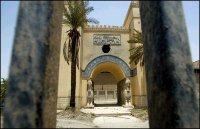Saturday, June 28, 2003
Another Saturday and another Iraq Museum pulse-pounder in a Washington Post that seems manically intent upon personally tying a big floppy happy ending bow to the entire sad story of the looting at the Iraq National Museum and robbing me of much deserved weekend sunshine through excessive desktop proximity.

Iraq National Museum
Unknown Washington Post staff writer Linda Hales pens an upbeat, chirpy and often misleading piece of Postian spin:
Invitations have not yet been sent, but the Coalition Provisional Authority is about to stage the first art exhibition in post-war Iraq. The event, which is being planned for…an audience of international media, will show off the fabled Treasures of Nimrud…discovered earlier this month in a bank vault deep in the Central Bank of Iraq and is the pride of the cultural recovery effort…A Pentagon spokesman was quick to convey the importance of the Nimrud treasures as "among the most feared loss, and the most unique, significant architectural finds they had."
A regular reader of major western newspapers, or even this blog for that matter, should notice two things from the above excerpt:
First, the Treasures of Nimrud were never considered “missing” and it is absolute humbug to suggest otherwise. On April 28th The Associated Press reports General Tommy Franks saying:
In the past three days Iraqis had begun informing coalition forces of the whereabouts of the artifacts…Franks said ordinary Iraqis had told coalition forces that they wanted the items in coalition hands… He said some of the items had been taken out of the museums before the war started…
The May 6th edition of the New York Times:
“A top British Museum official said yesterday that his Iraqi counterparts told him they had largely emptied display cases at the National Museum in Baghdad months before the start of the Iraq war, storing many of the museum's most precious artifacts in secure "repositories"…The official, John E. Curtis, curator of the Near East Collection at the British Museum, said he believed that American authorities now knew the locations of the artifact repositories but that as a precaution against further looting were not disclosing them.”
Or the May 7th edition:
The museum's gold and silver pieces are believed to be in underground vaults at the bombed-out central bank. Bogdanos' team found those vaults intact Tuesday, though no one seems to know which ones contain the artifacts or how to get into them.
Or, even, a lowly sentence from May 8th Washington Post:
Officials said the investigators are following up on reports that many artifacts are stored in several vaults beneath the headquarters of the Iraqi Central Bank in Baghdad.
Secondly, the bright-eyed Ms. Hales fails to mention that the fabled treasures were trapped for weeks in sewage-flooded vaults under the wreckage of the Coalition bombed Iraq Central Bank.
But bad smells are not exclusive to Nimrud’s treasures as we see the one consistent Coalition objective, public relations:
With people still dying in the streets, an art exhibit could seem frivolous. The timing, at the start of the July 4 holiday news cycle, might also seem overtly propagandistic. But as the White House has learned in the aftermath of war in Iraq, art is a mighty weapon in the battle for hearts and minds. Lose or abuse the treasures of ancient civilizations, or fail to prevent others from doing damage, and incur a blast of international disapproval. Preserve artifacts and share the heritage of humankind, and perhaps, over time, even a foreign invader may gain respect… In an age of televised war, images have also become weapons. Scenes of devastated museum galleries were sent around the world in April, along with considerable misinformation about how many objects had been looted and possibly destroyed… asked whether politics played a part in coalition decision-making, Proietti [Giuseppe Proietti, a senior cultural adviser to the coalition] laughed and assured that none were involved in the choice of Assyrian objects.
I find it amusing that persons in the Bush administration, of all administrations, use a "reporter" to shill their pathetic complaint that they have been victims of misinformation! Hold the phone, boys and girls, but didn't old H. W. his-own-self hone this nasty game to perfection in days of yore?
The story concludes with a brief mention of the looting still occurring across Iraq:
One archaeologist who has trekked into the desert…Joanne Farchakh, a Lebanese archaeologist and writer for the French magazine Archeologia, made her way to several ancient Sumerian sites in the south and to Mosul, Nimrud and Nineveh in the north…[She] described thousands of peasant diggers, some of them armed, encamped on ancient sites. "They dig every day," she said. "Traders come and pick up the antiquities every day. It's a massacre on archaeology, a mass grave of culture. These sites just look like the surface of the moon."
No mention of the Warka Vase, formerly the most prized of Iraq antiquities, in today’s Washington Post story. The Coalition spokesperson last quoted by the Post attesting to Warka’s undamaged condition has been contradicted by other media and photographic proof of significant damage to the vase on the site of the University of Chicago’s Oriental Institute (Jun 24 post).
It would seem that the Post’s reputation would be better served by gathering supporting quotations from more than a lone progression of unknown Coalition spokespeople.
Unless, of course, if the misleading quotations are intended to do just that.
Photo: Jamal Said-Reuter's

